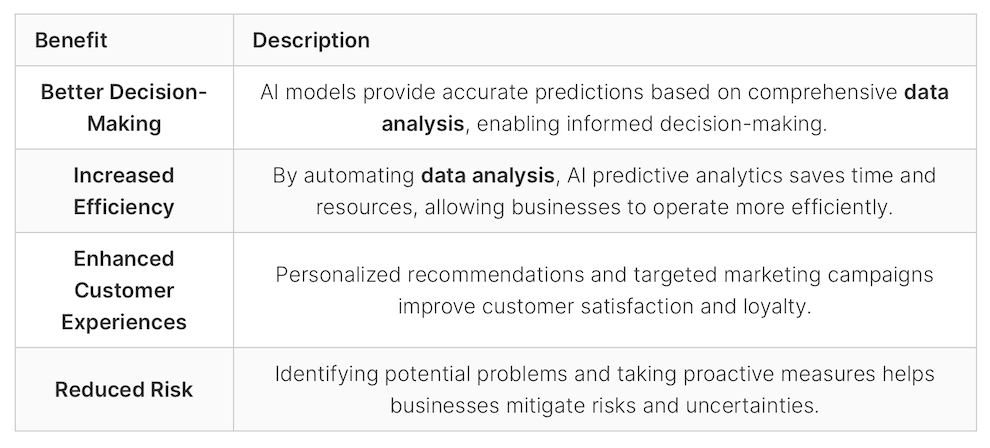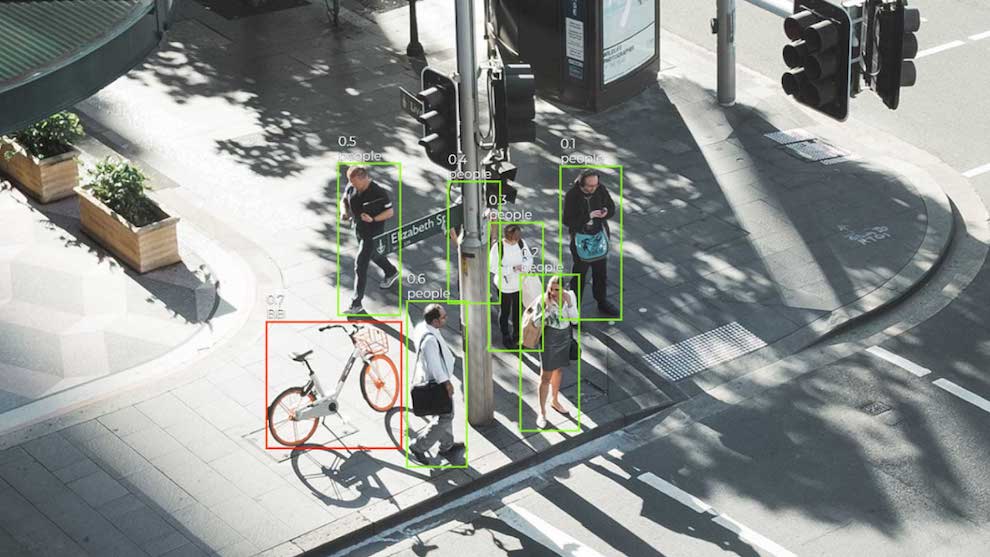Artificial Intelligence (AI) has transformed the landscape of predictive analytics, enabling companies to quickly process and examine enormous datasets. Through AI technologies like machine learning, it’s possible to uncover significant insights and trends from historical data. These findings allow for precise forecasts of future events, providing businesses with a strategic edge and enhancing decision-making in various business sectors.
A major advantage of integrating AI into predictive analytics is the capacity to refine business operations. For instance, AI algorithms can improve inventory management by examining sales history, consumer behaviour, and market movements. By accurately forecasting demand, companies can adjust their inventory levels, lowering expenses and reducing the chances of running out of stock or having excess inventory.
But by far the biggest advantage is the ability to enjoy vastly superior sales figures while drastically reducing the cost to do so, by utilising a sophisticated appreciation of each individual consumer, as you now capture use data on their interests, purchases and buying habits. This aspect of AI ecommerce is hyper-personalisation, and we have published a report on the leading 30 hyper-personalisation software vendors globally, and their respective distinctions. It is essential to stress that AI enables autonomous actions, rather than automatic, for clarity, human beings don’t need to touch it – at all!
Further, AI-driven predictive analytics plays a crucial role in refining marketing strategies. By analysing information on customer demographics, preferences, and actions, AI algorithms can create tailored suggestions and targeted ads. This approach not only boosts the success of marketing initiatives but also elevates the customer experience, leading to higher engagement and conversion rates.
The strength of AI in forecasting analytics is rooted in its capacity to manage intricate data sets and uncover significant understanding. Through the use of AI’s features, companies can make decisions based on data, boost productivity, and improve the satisfaction of customers.

Understanding AI Predictive Analytics
In the realm of forecasting analytics, artificial intelligence (AI) has transformed the manner in which companies examine data and extract meaningful insights. By leveraging AI methods like deep learning, text analysis, and image recognition, companies can explore the vast territory of data examination and forecast future occurrences or results with precision.
At the heart of AI forecasting analytics are three fundamental elements: information, methods, and forecasts. Initially, large and varied data sets are employed to educate AI models, equipping them with the necessary information to detect patterns and forecast future events. These data sets can encompass everything from consumer behaviour information to past market movements and more. Following the training of AI models, advanced algorithms are utilized.
These algorithms sift through the data, revealing significant insights and patterns that might have otherwise been overlooked. Through the application of intricate mathematical equations and statistical methods, these algorithms can scrutinise the data from various perspectives, resulting in more precise forecasts. In the end, the primary result of AI forecasting analytics is forecasts. These forecasts provide companies with a peek into what’s to come, enabling them to make well-informed choices, craft effective strategies, and secure a competitive advantage.
With insights from AI, companies can streamline their operations, customize their marketing approaches, and improve the customer journey. Nonetheless, it’s crucial to acknowledge that AI forecasting analytics isn’t infallible. The reliability of forecasts depends on the calibre of the data used, the algorithms applied, and the ongoing enhancement of the models. It represents a perpetual cycle of learning and refinement.

Advantages of AI in Predictive Analytics
By integrating artificial intelligence into predictive analytics, companies can gain numerous advantages:
Effective data examination: AI systems are capable of handling extensive data sets rapidly, allowing companies to uncover useful insights more quickly.
Precise forecasts: AI algorithms use sophisticated statistical methods and machine learning to produce more exact forecasts, offering companies greater assurance in their decision-making.
Pattern recognition: AI models can detect intricate patterns and relationships in the data that might not be noticeable to human analysts, resulting in more profound understanding and more precise forecasts.
Benefits of AI Predictive Analytics
Artificial Intelligence predictive analytics provides a wide range of advantages for companies, transforming how choices are made and processes are handled. By using AI algorithms for predictive modelling, businesses can discover precise and dependable forecasts, resulting in improved decision-making, higher productivity, improved customer satisfaction, and decreased danger.
Improved Decision-Making
Through AI predictive analytics, companies can improve their decision-making by utilizing precise forecasts obtained from extensive and intricate data sets. By examining records and employing AI methods, companies can discover trends, patterns, and relationships that might be overlooked by human experts. These findings enable leaders to make knowledgeable decisions, refine plans, and maintain a competitive edge.
Increased Efficiency
AI predictive analytics streamlines the data examination procedure, minimizing the need for manual work and enhancing productivity. AI algorithms are capable of quickly handling extensive data sets, pinpointing patterns and irregularities as they occur. Through the automation of data examination, companies can conserve time, resources, and labour, enabling staff to concentrate on more important duties and strategic plans.
Enhanced Customer Experiences
Hyper-personalisation at an unprecedented level is crucial for providing outstanding experiences to customers, and artificial intelligence’s predictive analytics plays a vital role in making this possible.
Through the examination of customer information, artificial intelligence algorithms can create hyper-personalised suggestions and choices of products, aligning with each customer’s likes and patterns of behaviour. This degree of personalisation enhances customer happiness, ensuring continuous relevance and interaction, leading to a significant boost in sales. Furthermore, artificial intelligence predictive analytics allows companies to grasp what customers want and like, allowing them to customise their offerings accordingly. By foreseeing what customers will do and prefer, businesses can adjust their approaches, guarantee customer contentment, and surpass their expectations.
Reduced Risk
Machine learning predictive analysis is essential for spotting possible dangers and unknowns before they become apparent. By examining records and utilising machine learning methods, companies can spot early warning signals, trends, and irregularities that could suggest future dangers.
This forward-thinking strategy allows companies to take preventative actions, reduce the likelihood of disruptions, and lessen the effect of dangers on their day-to-day activities and financial results. By incorporating machine learning models into predictive analysis, companies can enhance their decision-making, make processes more efficient, and improve customer experiences. With better decision-making, increased operational effectiveness, tailored customer engagements, and a decrease in risks, companies can achieve steady growth and remain competitive in the ever-changing business environment.
Optimizing Inventory and Delivery with AI and Predictive Analytics
Artificial Intelligence and predictive analytics have transformed the approach to managing inventory and enhancing delivery operations for businesses. By utilising AI models and predictive analytics, organisations can make informed decisions, cut expenses, and boost customer happiness.
A major benefit of employing AI and predictive analytics is the capacity to use up-to-the-minute information gathered from IoT devices and various monitoring systems. This information offers companies crucial insights into stock levels, enabling them to efficiently manage replenishment and prevent shortages.
It also allows for the optimisation of delivery paths, ensuring prompt and effective delivery. AI algorithms are crucial in the management of inventory and the optimisation of delivery processes. By examining past data and taking into account external elements like weather and traffic, AI algorithms can forecast demand and refine trucking paths. This approach not only aids in fulfilling customer needs but also lowers fuel expenses and lessens the risks involved in delayed deliveries.
Predictive Analytics for Data Transformation
A major advantage of using AI in predictive analytics is the ability to transform data. AI algorithms can extract important insights from varied and intricate data sets, enabling companies to achieve a full understanding of their activities. Data transformation includes examining and reorganising vast quantities of data to spot patterns, relationships, and irregularities. Through the use of AI methods, companies can reveal concealed knowledge that could greatly influence their decision-making strategies.
Integrating artificial intelligence models into predictive analytics equips companies with a potent instrument for converting data into useful knowledge. Through examining extensive data sets, recognizing trends, and generating precise forecasts, organisations can make knowledgeable choices that propel development and achievement. With careful planning, strategies for gathering data, and the application of AI methods, companies can tap into the full capabilities of predictive analytics and secure insights that result in concrete outcomes.
Conclusion
By integrating AI models into predictive analytics, companies can access valuable insights, make better decisions, and streamline various operations. Utilising AI methods in data analysis can give companies a competitive advantage and lower their exposure to risks. The combination of AI and predictive analytics provides practical insights that guide strategic choices and improve the overall experience for customers.
One significant advantage of using AI models for predictive analysis is the improvement in supply chain efficiency. Through better inventory control and more efficient delivery, companies can cut costs and boost customer happiness. AI-powered forecasts allow businesses to manage inventory more effectively and optimise delivery routes, leading to better supply chain performance.
To fully harness the potential of AI in predictive analytics, companies need to keep up with the changing field of data analysis. Adopting AI methods in the predictive analysis approach is essential for companies to remain competitive in the market. By adopting AI models, companies can discover underlying patterns, spot trends, and make well-informed decisions. It’s crucial to invest in the right technology and skills to successfully apply and use AI in predictive analytics and data analysis workflows.





